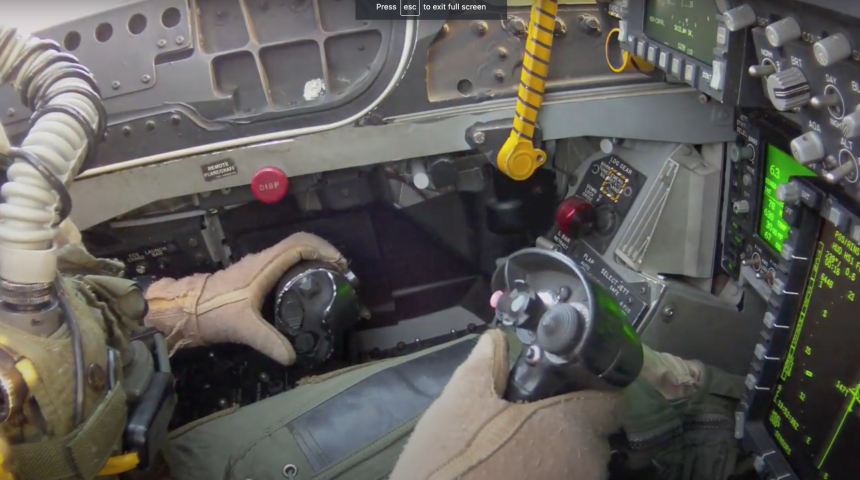F/A-18F trap landing from a great, different perspective.
There are many clips showing carrier landings from inside the cockpit but you won’t find many videos like the one in this post. Filmed in the cockpit of a Hornet “in the groove” (the final part of the approach flown with level wings) the footage below focuses on the hands of the pilot as he controls throttle and stick until the successful arrested landing aboard the carrier.
The video is not recent: although it was uploaded to Youtube in 2018, the trap landing occurred almost 10 years ago, in 2011 (based on the other videos posted by the same pilot) during one of the last cruises of USS Enterprise, that was retired from active service in 2012.
“This video was taken during a foul-weather recovery aboard the USS Enterprise,” says Austin Hulbert, a pilot with the VFA-211 in the comment to the video. “There was a pretty big thunderstorm that was dumping down so much rain we could not see the ball (“meatball”=the visual landing aid we use to land aboard the ship) so the LSOs (Landing Signals Officers) had to talk all the aircraft down. The control inputs are bigger than normal due to the gusts and turbulent winds.”
Indeed, you can see the amount of inputs on the throttle and stick that are required to keep the desired airspeed, rate of descent and attitude in bad weather. The left MFD (Multi-Function Display) shows the attitude indicator and gives a clear idea of the rotation of the jet around the roll and pitch axis of the VFA-211’s “Rhino” (as the F/A-18F is dubbed in U.S. Naval Aviation lingo) as it approaches the flight deck. Impressive.
“The item that flew forward was a divert card to plan for a fuel divert in case we weren’t able to get the jet aboard. Fortunately, the foot well is well-barriered and the card was easy to retrieve once I got out of the jet.”
Arrested landings.
We have often explained how trap landings aboard U.S. aircraft carriers. There’s a full post posted on this topic here for you to deep dive if interested. Following is an excerpt that provides some details that allow you to better understand the role of the LSO, mentioned by Austin Hulbert in the comment to the footage above.
From the last three quarters of a mile all the way to touchdown the pilot approaching a U.S. aircraft carrier can rely on LSO (Landing Signal Officers – radio callsign “Paddles”) talkdown. LSOs are skilled and experienced pilots whose job is to watch the deck-landing of all the airplanes and provide the pilots with radio guidelines to adjust the final phase of the approach, and complement IFLOLS (Improved Fresnel Lens Optical Landing System) and ICLS (Instrumental Carrier Landing System) visual information.
Landing on a carrier is anything but easy as correctly setting up the aircraft for landing is not enough: as a matter of fact, difficulties in deck-landing lie in the fact that the angled flight deck moves as the carrier sails in rectilinear motion.
Therefore the pilot must follow a steady moving deck. Instructions radioed to the pilots (extremely important also to prevent the pilot from concentrating on the deck, thus not paying as much attention to the optical landing system) are concise: “Little low”, “Little right”, “Power”, etc.
Even though it’s only two of the LSO team to be in contact over the radio with the plane (a duty one and a supervisor), on the special aft platform a team of five or six LSO-qualified pilots work on: at least one member for each embarked squadron, supporting the two CAG LSOs the whole crew depends on.
LSOs have a double task: along with helping the pilots out through the last fifteen-eighteen seconds of their flight (the most critical part of it), LSOs grade every plane’s deck-landing (whether successful or not) according to a model which guarantees every naval aviator proficiency and training in the difficult art of getting the aircraft back onto the deck.
Under LSOs’ disposal is a specially-provided radio-equipped emplacement fitted out with light controls, control workstation, Integrated Launch and Recovery Television Surveillance System (ILARTS) -that is a sort of camera aligned with the deck which catches and tapes any approaching plane and has eventually replaced the outdated Pilot Landing Aid Television (“PLAT”, on all carrier’s closed-circuit televisions)- and the Head Up Dislpay, which supplies the aircraft and vertical speed as well as the wind direction and intensity. Paddles job has very little to do with technology though and it mostly calls for a well-trained eye for the concise guidelines pilots are provided with over the radio are based almost only upon visual perceptions of the pilots who watch the in-coming traffic from the LSOs platform and suggest the various corrections according to aircraft’s landing and nav lights.
BTW, today the Navy turns 245. Happy Birthday Navy!









